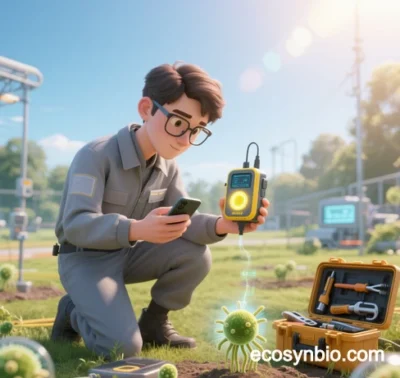
Ecosyn Bio: Synthetic Biology for Reconstructing Natural Ecosystem Functions
Synthetic biology is revolutionizing natural ecosystems through molecular-level redesign, creating artificial biological components, metabolic networks, and communities to enhance or restore ecological functions. Termed “Ecosyn Bio” (Ecological Synthetic Biology), this field integrates biotechnology and ecology to engineer sustainable, self-balancing ecosystems. Below is a systematic exploration of its technical frameworks, applications, risk governance, and future directions.
I. Technical Framework: Multiscale Design from Genes to Ecosystems
1. Ecological Programming of Genetic Elements
- Carbon Fixation Pathways: CRISPR-Cas12f-edited cyanobacteria with enhanced Calvin-Benson-Bassham cycles triple CO₂ fixation rates while producing biodegradable PHA plastics.
- Pollutant Degradation Toolkits: Cross-species “detox gene clusters” (e.g., aromatic dioxygenases, heavy metal chelators) enable soil microbes to mineralize organic pollutants via horizontal gene transfer.
2. Synthetic Ecological Networks
- Cross-Species Metabolic Coupling: Constructed wetlands with “algae-bacteria-plant” symbiosis—cyanobacteria fix nitrogen for plants, root exudates fuel sulfate-reducing bacteria, forming self-sustaining sulfur cycles.
- Biomimetic Energy Chains: Solar-driven systems pair hydrogen-producing algae (Chlamydomonas) with methanogenic archaea for solar-to-hydrogen-to-methane energy cascades.
3. Ecosystem-Level Dynamic Regulation
- Synthetic Quorum Sensing: Engineered E. coli in artificial wetlands modulate denitrifying bacteria via AHL signaling, responding dynamically to nitrate fluctuations.
- AI Ecosystem Simulators: LSTM neural networks and cellular automata predict synthetic organism dynamics in the wild, preventing ecological niche invasion.
II. Applications: From Restoration to Systemic Transformation
1. Biodiversity Conservation & Species Revival
- Endangered Species Enhancement: Gene drives introduce blight-resistant Cr4 into endangered North American whitebark pines, boosting survival rates without compromising genetic diversity.
- De-Extinction: Ancient DNA synthesis and embryo editing resurrect the dodo’s digestive genes, restoring seed dispersal for Mauritius’ tambalacoque trees.
2. Carbon-Nitrogen-Phosphorus Cycle Engineering
- Industrial Emission Conversion: “Synthetic biofilters” near steel plants use engineered Nostoc to absorb CO₂ and secrete polysaccharides, driving nitrogen-fixing bacteria to close C-N loops (12 tons CO₂/ha/year).
- Marine Plastic Remediation: Ideonella sakaiensis-algae consortia degrade PET into TPA, which engineered diatoms convert into β-carotene, coupling pollution cleanup with high-value product synthesis.
3. Extreme Environment Ecosystems
- Desert Oasis Synthesis: Sahara “PV-cyanobacteria-sea buckthorn” systems use solar panels for shade, salt-tolerant Synechococcus for sand stabilization, and C4-photosynthetic sea buckthorn for low-light efficiency.
- Polar Adaptations: Synthetic Antarctic lichens combine frost-resistant fungi with DHA-producing algae, creating self-sustaining primary producer networks.
III. Risk Governance: Biosafety and Ethics
1. Genetic Containment
- Quadruple Genetic Locks: Engineered auxotrophy, thermosensitive kill switches, optogenetic CRISPR suppressors, and density-dependent lysis ensure >99.99% escapee mortality within three generations.
- Ecological Firewalls: Synthetic tRNA suppressors block gene flow to wild relatives, demonstrated in Australia’s cane toad control.
2. Impact Assessment
- Multilayer Monitoring: eDNA metabarcoding tracks synthetic organisms, while satellite remote sensing monitors NDVI and albedo.
- AI Toxicity Prediction: Graph neural networks (GNNs) predict bioaccumulation of synthetic metabolites, outperforming QSAR models by 41%.
3. Global Governance
- International Protocols: The Cartagena Protocol’s expanded “prior informed consent” framework governs environmental releases, supported by a global ecological compensation fund.
- Indigenous Knowledge Integration: Amazon restoration projects encode traditional practices (e.g., slash-and-burn cycles) into synthetic microbial quorum sensing rules.
IV. Future Frontiers: From Earth to Interplanetary Systems
1. Interplanetary Ecosystems
- Mars Resource Utilization: Radiation-resistant Chroococcidiopsis GE1-52 produces oxygen and bioconstruction materials in Martian regolith under 0.63x Earth irradiance.
- Lunar Closed Loops: “Algae-cockroach-microbe” systems convert CO₂ into glucose, process waste into chitin, and synthesize biodegradable plastics.
2. Quantum Biology & Ecological Control
- Photosynthetic Tunneling: Gold nanoparticle-enhanced cyanobacterial membranes achieve 92% light-capture efficiency via plasmonic resonance, defying classical limits.
- Magnetic Remediation: Magnetospirillum SynBio1 navigates oil spills via external magnetic fields for targeted bioremediation.
3. Cognitive Ecosystems
- Plant Neural Mimicry: Synthetic Trichoderma fungi mimic calcium signaling to transmit fire alerts and chemical signals across tree species.
- DNA Ecological Memory: Engineered lichens record century-scale climate shifts via methylation patterns, creating living environmental databases.
Conclusion: A Paradigm Shift in Ecosystem Design
Ecosyn Bio redefines humanity’s role from passive observers to active architects of ecosystems, grounded in three principles:
- Modularity: Deconstructing ecological services (carbon capture, purification, pollination) into programmable biological modules.
- Dynamic Robustness: Maintaining stability through synthetic quorum sensing and AI feedback.
- Cross-Scale Integration: Bridging molecular metabolic engineering with landscape-scale ecological modeling.
As the WWF envisions: “By 2040, 30% of degraded ecosystems will be functionally restored via synthetic biology.” Achieving this demands collaboration across science, policy, and society to balance innovation with ethics, harmonizing engineered and native ecosystems.
Data sourced from publicly available references. For collaborations or domain inquiries, contact: chuanchuan810@gmail.com.





